Temperature blunders can quickly derail your soap making efforts. Working outside the ideal 90-110°F range often leads to soap volcanoes, false trace, or soda ash formation. You'll face problems when your lye and oils differ by more than 10°F or when you rush the cooling process. Cold temperatures cause oils to solidify prematurely while excessive heat accelerates saponification unpredictably. Proper temperature monitoring with calibrated digital thermometers prevents these common pitfalls. Mastering temperature control transforms your soap from problematic to perfect.
Common Temperature Blunders That Ruin Your Soap
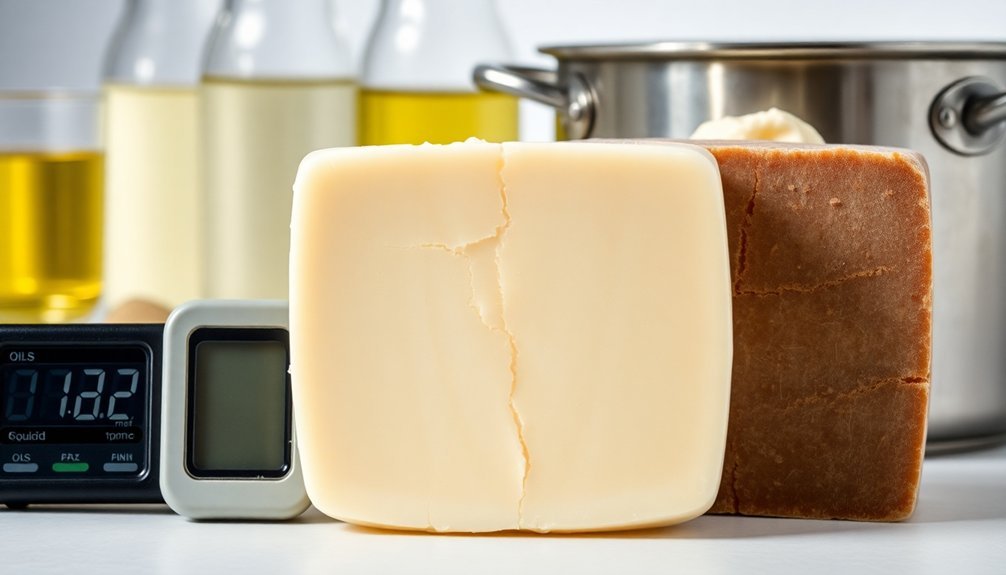
While making soap might seem straightforward, temperature miscalculations can quickly transform your artisanal creation into a disappointing mess. One of the most common soap making mistakes is using lye temperatures above 200°F, which can trigger soap volcanoes and uneven texture.
If your lye solution is too cold when combined with oils, you'll notice false trace occurs before proper emulsification happens. To prevent soda ash formation, avoid working below 90°F.
Though high temperatures enhance colors and can help avoid gel phase issues, they may cause glycerin rivers if not controlled.
For ideal results, keep your soap making oils and lye within a 10°F temperature range of each other, ideally between 90-110°F. This precise temperature control guarantees proper emulsification and gives you the smooth, professional finish you're aiming for.
Ignoring the Critical 90-110°F Sweet Spot for Soap Making
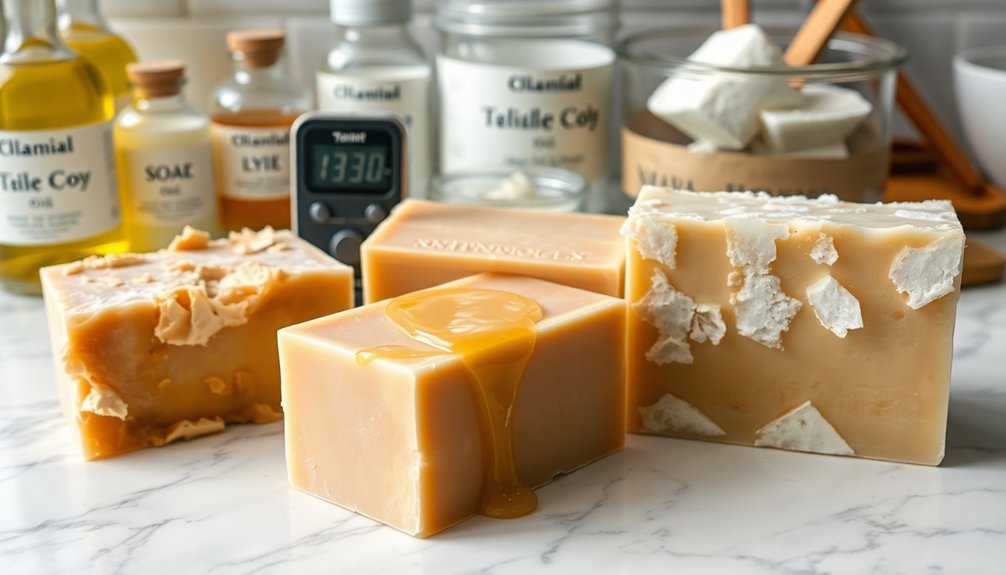
The narrow 90-110°F window represents soap making's most overlooked yet fundamental requirement. When temperatures fall outside this ideal temperature range, your saponification process suffers, potentially ruining an entire batch. Your lye and oils must stay within 10 degrees of each other to prevent false trace—that deceptive thickening that isn't actually saponification.
- Temperatures above 120°F accelerate trace but risk cracking and glycerin rivers in your final soap.
- Solid oils with higher melting points must be completely liquefied before mixing to avoid cloudiness.
- Using a digital laser thermometer guarantees precision and helps maintain the critical sweet spot.
Don't underestimate temperature's impact on your soap making success. When you respect this fundamental range, you'll achieve consistent, smooth results without the frustration of temperature-related failures.
Rushing the Cooling Process of Lye Solution
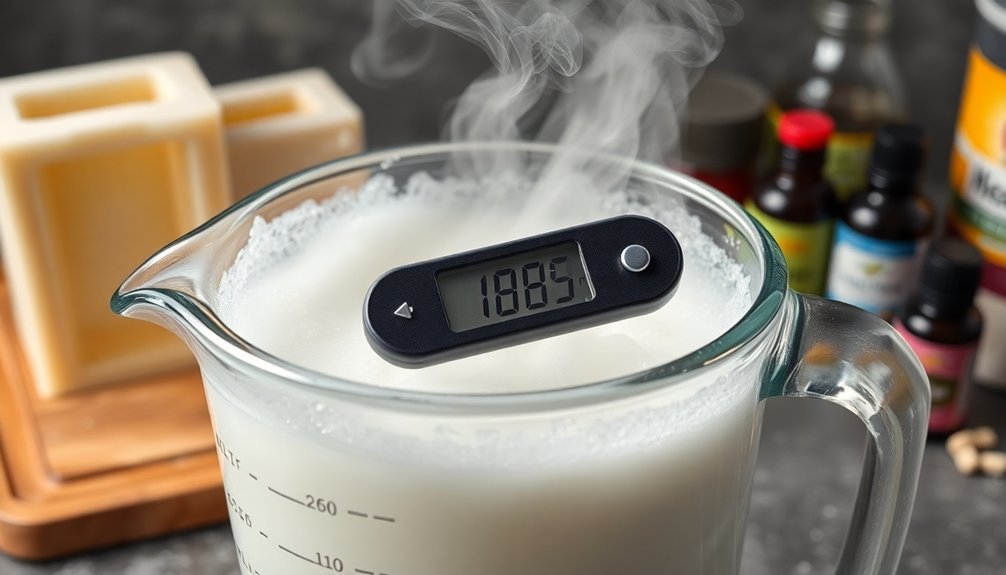
You'll regret rushing your lye solution's cooling process when you watch your carefully crafted soap batter separate into an oily mess.
Temperature shock occurs when too-hot lye meets your oils, causing the lye to solidify upon contact or accelerating saponification at an uncontrollable rate.
Monitoring with a digital thermometer until your solution reaches 120-130°F isn't just best practice—it's the difference between soap-making success and a frustrating batch failure.
Impatience Causes Separation
Rushing the cooling process of your lye solution can quickly derail an otherwise promising batch of soap. When you don't allow your lye solution to reach the ideal temperature range of 90-110°F (32-43°C), you're risking separation between your oils and lye.
This impatience often leads to an uneven mixture that won't properly saponify, preventing you from achieving a high-quality soap.
- Temperature matters—a solution that's too hot (up to 200°F during mixing) accelerates saponification, causing thick trace too quickly.
- Cooling to around 100°F helps prevent false trace and guarantees a smooth, well-integrated soap batter.
- Patience during cooling helps you avoid common issues like glycerin rivers and separation.
Temperature Shock Problems
Temperature shock represents one of soap making's most overlooked pitfalls when crafting your batches.
When you rush the cooling process of your lye solution, you risk combining it with oils at temperatures that are too extreme for ideal blending.
If your lye solution is too hot (above 110°F), your soap may prematurely enter gel phase, affecting both appearance and texture.
Conversely, a too-cold solution (below 90°F) can solidify oils upon contact, creating false trace where the mixture appears thick but hasn't properly saponified.
For a smooth saponification process, allow your lye solution to cool naturally to the perfect temperature range of 90-110°F (32-43°C).
Using a digital laser thermometer for monitoring temperature guarantees both lye and oils remain within 10 degrees of each other, preventing temperature shock and guaranteeing consistent, quality soap.
Mismatched Oil and Lye Temperatures
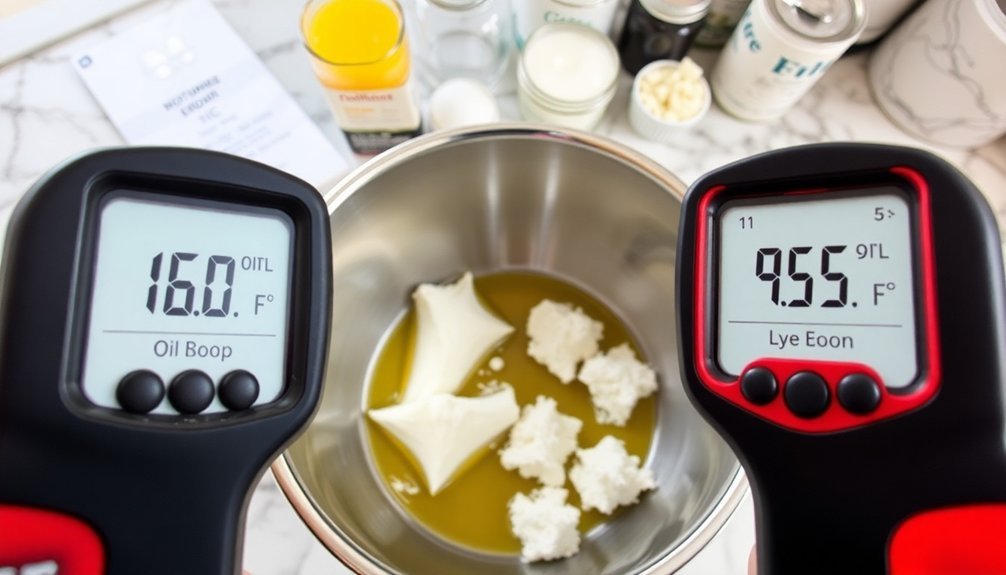
When creating handmade soap, one of the most critical factors affecting your success is maintaining proper temperature balance between your oils and lye solution. Mismatched oil and lye temperatures can sabotage your batch, leading to frustrating issues like false trace when your cold lye solution solidifies warm oils upon contact.
For peak soap quality:
- Keep both components within 10 degrees of each other, ideally between 120°F-130°F
- Watch for warning signs: grainy appearance often indicates your lye was too cold, while thick trace developing rapidly suggests your lye was too hot
- Practice consistent monitoring temperatures throughout your process
Remember that temperature extremes impact saponification dramatically—too hot (above 200°F) accelerates the reaction unpredictably, while too cold (below 100°F) may prevent proper chemical reactions entirely.
False Trace: The Cold Temperature Deception
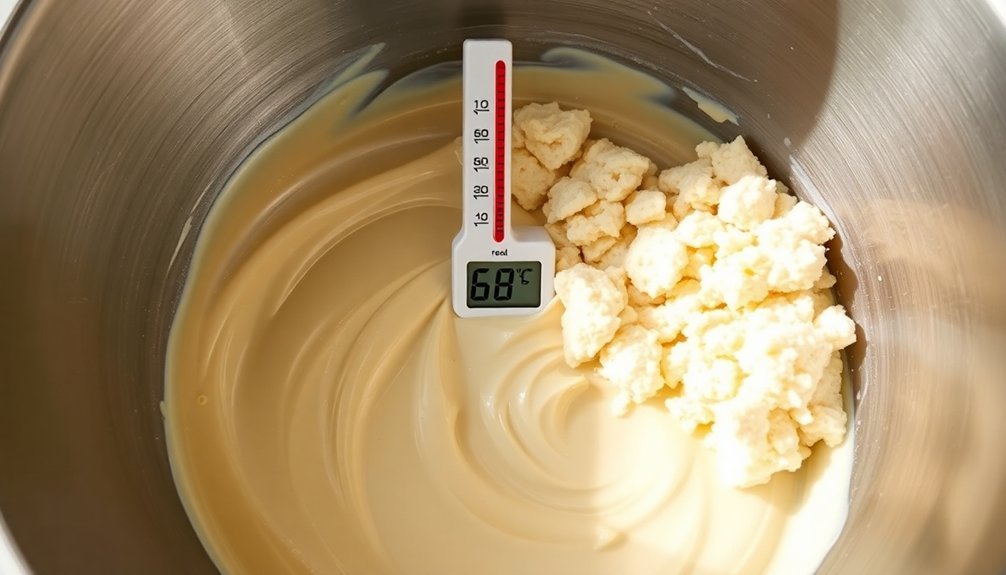
False trace can fool you into thinking your soap has reached proper emulsification when cold temperatures have merely caused oils to solidify, creating a grainy, pudding-like texture.
You'll know you're dealing with this temperature-induced imposter if your soap batter feels gritty rather than smooth, or if hard oils appear to be crystallizing in the mixture.
If you encounter false trace, don't panic—simply warm your soap batter gently over a double boiler until it reaches 110°F, then continue mixing until you achieve genuine trace with a smooth, pudding-like consistency.
Recognizing False Trace
Many soapmakers have been fooled by what appears to be trace but isn't. This deceptive "false trace" occurs when your soap batter thickens prematurely due to cool temperatures rather than actual saponification.
When your oils and lye solution fall below 90°F, solid fats can recrystallize, creating a grainy, pudding-like texture that mimics true trace.
To identify false trace and preserve your soap's quality:
- Look for a grainy or lumpy appearance in your batter, which indicates solidified fats rather than proper emulsification
- Notice if the thickness develops suddenly instead of gradually thickening as true saponification occurs
- Check if continued mixing causes the batter to thin out again as friction heat remelts the solid fats
Always guarantee your ingredients remain at proper temperatures to avoid this common pitfall.
Repairing Accelerated Batter
The dreaded false trace can quickly derail your soap-making process, but it's not irreversible. When your batter accelerates unexpectedly due to cool temperatures, don't panic. Continue mixing with determination, as the heat generated during saponification will eventually remelt those solidified oils causing the grainy appearance.
To fix accelerated batter, make sure your workspace temperature stays warm. If you notice false trace forming, increase your mixing speed to generate friction heat. Always maintain both lye solution and oils between 120-130°F (49-54°C), keeping them within 10 degrees of each other for best results.
Prevention remains your best strategy—invest in a digital thermometer to monitor temperatures accurately throughout your soap making process.
Overheating Delicate Additives and Fragrances
When crafting handmade soap, you'll quickly discover that timing and temperature management are critical for preserving the integrity of your delicate additives and fragrances.
Overheating can cause essential oils to lose their therapeutic properties and fragrance oils to accelerate saponification, leading to ricing or seizing in your batter.
For best results, add your fragrances when your soap mixture reaches the ideal temperature range of 90°F to 110°F (32°C to 43°C). This guarantees maximum scent retention and prevents issues in your final product.
- Wait until lye and oils have cooled sufficiently before adding delicate additives
- Monitor temperatures carefully – anything above 120°F (49°C) can degrade essential oils
- Incorporate fragrances at the right moment to prevent discoloration and maintain scent longevity
Failing to Adjust for High-Melting Point Oils
You're likely to encounter temperature stratification problems when your thermometer isn't properly calibrated, giving false readings for your high-melting point oils.
Your cooling curve miscalculations can lead to premature solidification, especially when working with cocoa butter or palm oil that require temperatures above 90°F to remain liquid.
Without accurate temperature monitoring throughout the process, these oils will create uneven batches with false trace, ruining what could have been a perfectly smooth soap.
Inadequate Thermometer Calibration
Because high-melting point oils like cocoa butter and palm oil require precise temperature monitoring, inadequate thermometer calibration can derail your entire soap batch.
When your thermometer reads lower than actual melting points (93°F for cocoa butter, 96°F for palm oil), you risk false trace—where your soap batter thickens prematurely without proper saponification.
To guarantee accurate readings and consistent soap quality:
- Calibrate your thermometer regularly against a known temperature reference
- Fully melt and incorporate high-melting point oils before measuring temperature for the lye solution
- Consider using a digital laser thermometer for precise temperature readings between 90°F-110°F
Temperature Stratification Problems
Despite your best intentions, temperature stratification can sabotage your soap batch if you're working with high-melting point oils like cocoa butter and palm oil. When these oils aren't fully melted before meeting your lye solution, they'll quickly solidify, creating deceptive false trace that masks incomplete emulsification.
For successful saponification, maintain your lye and oils within 10°F of each other, ideally around 100°F. Those cloudiness spots you're seeing? They're solidified fatty acids disrupting proper emulsification.
By ensuring your high-melting point oils remain completely liquid when combining with lye, you'll avoid problematic temperature stratification throughout the soap-making process.
The payoff extends beyond smooth texture—you'll also minimize the risk of glycerin rivers and soap volcanoes during curing. Remember, proper temperature management isn't just about avoiding problems—it's about creating consistently superior soap.
Cooling Curve Miscalculations
When soapmakers overlook the cooling curve of high-melting point oils like cocoa butter and palm oil, they're setting themselves up for frustration.
These stubborn fats solidify quickly as temperatures drop, creating deceptive false trace during saponification that isn't actual soap formation at all.
Proper temperature management is essential when working with these challenging oils.
For successful batches, heat your oils to 120-130°F (49-54°C) before adding lye, ensuring they're completely melted for smooth incorporation.
- Monitor your soap batter constantly as high-melting point oils cool faster than you think
- Allow extra heating time for hard oils like cocoa butter (melts at 93°F) to fully liquefy
- Watch for graininess in your mixture—this signals solidifying fats, not true trace
Adjusting your process for these cooling curves yields consistent, professional-quality soaps without separation or texture issues.
Temperature Shock and Soap Separation
One of the most frustrating issues you'll encounter in soap making occurs if your lye solution and oils aren't within 10 degrees of each other. This temperature shock can derail your entire batch.
When your lye solution is too cold, it may cause oils to solidify upon contact, preventing them from properly emulsifying. Conversely, excessively hot lye accelerates saponification too quickly, leading to premature thickening and eventual soap separation.
To avoid these pitfalls, always monitor both components carefully. The ideal range for successful blending is between 90°F and 110°F.
Invest in a good digital thermometer to track temperatures accurately throughout the process. This simple tool helps guarantee your ingredients blend harmoniously, preventing the disappointment of watching your carefully crafted soap separate due to avoidable temperature differences.
Neglecting Room Temperature's Impact on Your Batch
Many soap makers focus exclusively on the temperature of their oils and lye solution while completely overlooking their workspace environment. Room temperature dramatically influences the entire soap-making process, affecting everything from trace time to gel phase.
When your ambient temperature is too high (above 110°F), you'll notice accelerated saponification, potentially ruining intricate designs as your batch thickens prematurely.
Too cold, and you might encounter false trace—where your soap appears ready but hasn't properly saponified.
- A consistent room temperature between 90-110°F creates ideal conditions for controlled saponification
- Cooler environments often promote soda ash formation on your soap's surface
- Higher ambient temperatures can push your soap into full gel phase, enhancing colors but potentially causing unwanted reactions
Monitor your workspace temperature as carefully as you do your ingredients!
Heat Transfer Method Mistakes
Just as your workshop's ambient conditions affect your soap, improper execution of the heat transfer method can derail even the most promising batch.
When using this technique, you're counting on your hot lye solution to melt solid oils, but temperatures over 200°F will trigger rapid saponification or false trace.
Always weigh your oils first, then add the lye solution for even melting of high-melt-point ingredients like cocoa butter.
Gently stir until all oils are completely liquefied before blending to prevent separation during saponification.
Monitor the temperatures closely, aiming for a combined temperature of 120-130°F for ideal conditions.
If your oils solidify when the lye is added, you'll risk false trace—where your soap appears thick but hasn't properly saponified.
This common mistake can render your entire batch unusable.
Excessive Gel Phase From Improper Insulation
When your carefully crafted soap batch overheats during curing, you're likely witnessing excessive gel phase caused by improper insulation. Overinsulating your soap accelerates the saponification process, driving temperatures above 140°F and creating problems like alien brains or soap volcanoes.
While some gel phase can enhance colors, excessive high temperatures often lead to unwanted glycerin rivers and texture defects. Proper temperature management is essential for achieving that perfect balance.
- Keep temperatures between 120-130°F (49-54°C) for a controlled, beneficial gel phase
- Adjust your insulation based on your recipe's specific needs and ambient conditions
- Monitor fresh batches periodically to catch overheating before defects develop
Temperature-Related Soda Ash Formation
While excessive heat causes one set of problems, too-cool temperatures create their own distinctive challenge: soda ash. This white, powdery substance forms when unsaponified lye reacts with carbon dioxide in the air during cooler stages of curing.
To prevent this cosmetic nuisance, maintain soaping temperatures above 120°F (49°C). This encourages a complete gel phase, greatly reducing ash formation.
Remember to keep your lye and oil temperatures within 10°F (5°C) of each other to guarantee proper saponification. High humidity worsens soda ash development, so work in drier environments whenever possible.
If you've already spotted that frustrating white film, don't panic—gently steam the soap's surface or rinse with cold water after it sets. Monitoring temperatures during soap-making is your best defense against this common aesthetic flaw.
Digital Thermometer Inaccuracies and Their Consequences
Despite their convenience and digital display, thermometers can silently sabotage your soap batch through inaccurate readings. When your digital thermometer isn't properly calibrated, even a few degrees of discrepancy can greatly disrupt the saponification process, resulting in soap that's either too soft or too hard.
Regular calibration checks against known temperature sources like ice water (32°F) or boiling water (212°F) can prevent these problems.
Inaccurate liquid temperatures during soap making often lead to:
- Glycerin rivers that create unwanted marbling patterns
- Soda ash formation that dulls your soap's appearance
- False trace or overheating that ruins your entire batch
Remember that laser thermometers need to be specifically designed for measuring liquid temperatures; otherwise, they'll provide misleading readings that compromise your final product's quality.
Frequently Asked Questions
Does Temperature Affect Soap?
Yes, temperature greatly affects your soap. You'll need to maintain oils and lye between 90-110°F. If they're too hot, you'll get accelerated trace; too cold, you'll face false trace and soda ash.
What Is the Best Temperature to Cure Soap?
You'll want to cure your soap between 70°F and 85°F (21°C to 29°C). This range guarantees proper saponification without issues like soda ash. Keep the area well-ventilated for ideal hardening during the 4-6 week process.
What Temperature Melts Soap?
Soap melts between 120-130°F (49-54°C). You'll notice your soap bars beginning to soften at these temperatures. If you're working with soap, keep it below this range to maintain its solid form.
How to Prevent Soap From Overheating?
To prevent soap from overheating, you'll want to monitor temperatures closely (90-110°F), avoid over-insulating molds, use cooling techniques like refrigeration if needed, and reduce superfatting oils that can accelerate heat during saponification.
In Summary
You've now uncovered the temperature traps that can sabotage your soap. Remember, success lies in that 90-110°F sweet spot, properly cooled lye, and matched temperatures. Don't be fooled by false trace or careless heat transfer. Watch your insulation, prevent soda ash, and invest in accurate thermometers. With these temperature insights, you'll transform from making disappointing batches to crafting perfect, luxurious soap every time.

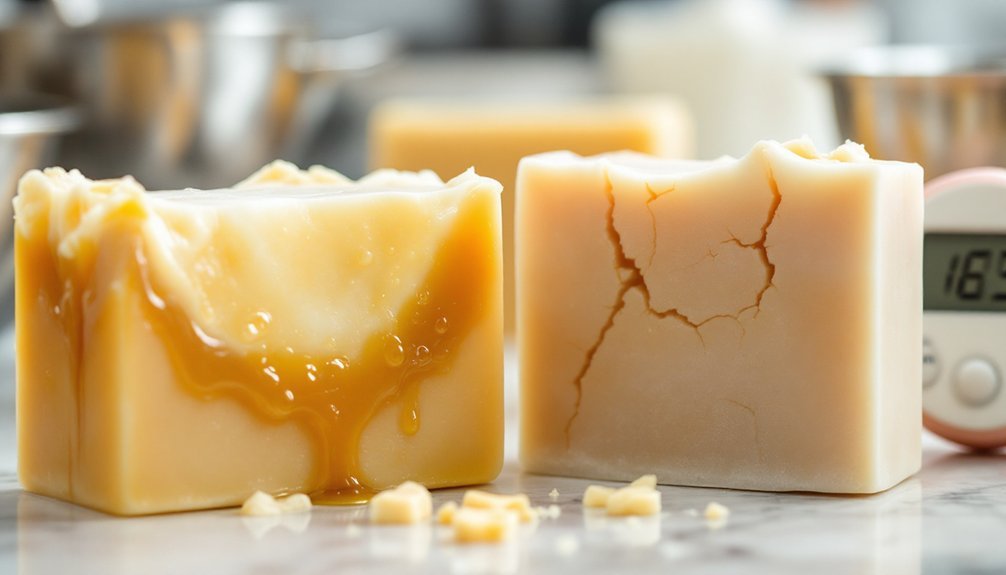



Leave a Reply